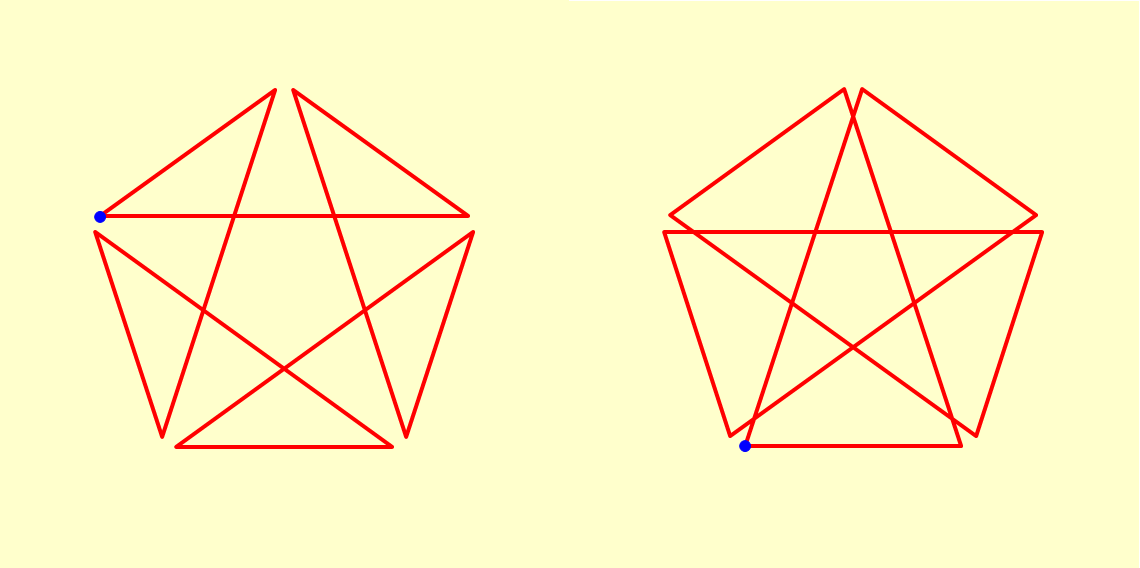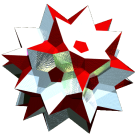As abstract polytope cid is isomorphic to gacid, thereby replacing pentagons by pentagrams.
Looks like a compound of the icosahedron (ike) and the great dodecahedron
(gad), and indeed edges coincide by pairs, but vertices are identified.
Note that without edge-doubling it would be a tetradic figure (type C).
–
Moreover it also could be taken, as Quickfur pointed out in 2022, as a different compound as well: the chiral-tetrahedrally symmetric compound of 4 teddi (type D).
Then however icosahedral edges fall into 2 classes of coincident edges: either 2 incident 3-5 edges or an incident pair of a 3-3 and a 5-5 edge.
Through the replacement of normal pentagons by complete pentagons (-x)5f, i.e. additional f-edges, this same set of faces
provides an even further type E. Vertices coincide by 5 then, x-edges by pairs.
Incidence matrix according to Dynkin symbol
o
5 / \ 5
x---o
3/2
x3/2o5o5*a (type A)
. . . | 12 | 10 | 5 5
-----------+----+----+------
x . . | 2 | 60 | 1 1
-----------+----+----+------
x3/2o . | 3 | 3 | 20 *
x . o5*a | 5 | 5 | * 12
o
5 / \ 5/3
x---o
3
o5/3o3x5*a (type B)
. . . | 12 | 10 | 5 5
-----------+----+----+------
. . x | 2 | 60 | 1 1
-----------+----+----+------
. o3x | 3 | 3 | 20 *
o . x5*a | 5 | 5 | * 12
o
5 / \ 5/2
x---o
3/2
x3/2o5/2o5*a (type B)
. . . | 12 | 10 | 5 5
-------------+----+----+------
x . . | 2 | 60 | 1 1
-------------+----+----+------
x3/2o . | 3 | 3 | 20 *
x . o5*a | 5 | 5 | * 12
o
5/4 / \ 5
x---o
3
o5/4x3o5*a (type A)
. . . | 12 | 10 | 5 5
--------+----+----+------
. x . | 2 | 60 | 1 1
--------+----+----+------
o5/4x . | 5 | 5 | 12 *
. x3o | 3 | 3 | * 20
o
5 / \ 5/4
x---o
3
o5/4o3x5*a (type A)
. . . | 12 | 10 | 5 5
-----------+----+----+------
. . x | 2 | 60 | 1 1
-----------+----+----+------
. o3x | 3 | 3 | 20 *
o . x5*a | 5 | 5 | * 12
o
5/4 / \ 5/2
x---o
3
x5/4o5/2o3*a (type B)
. . . | 12 | 10 | 5 5
-------------+----+----+------
x . . | 2 | 60 | 1 1
-------------+----+----+------
x5/4o . | 5 | 5 | 12 *
x . o3*a | 3 | 3 | * 20
o
5/4 / \ 5/3
x---o
3/2
o5/4x3/2o5/3*a (type B)
. . . | 12 | 10 | 5 5
----------+----+----+------
. x . | 2 | 60 | 1 1
----------+----+----+------
o5/4x . | 5 | 5 | 12 *
. x3/2o | 3 | 3 | * 20
o
5/4 / \ 5/4
x---o
3/2
x5/4o5/4o3/2*a (type A)
. . . | 12 | 10 | 5 5
---------------+----+----+------
x . . | 2 | 60 | 1 1
---------------+----+----+------
x5/4o . | 5 | 5 | 12 *
x . o3/2*a | 3 | 3 | * 20
β3o5o (type A)
both( . . . ) | 12 | 10 | 5 5
--------------+----+----+------
sefa( β3o . ) | 2 | 60 | 1 1
--------------+----+----+------
β3o . ♦ 3 | 3 | 20 *
sefa( β3o5o ) | 5 | 5 | * 12
starting figure: x3o5o
(Type C)
12 | 5 | 5 5
---+----+------
2 | 30 | 2 2 :4 incident faces
---+----+------
3 | 3 | 20 *
5 | 5 | * 12
as uniform compound
12 | 5 5 | 5 5 || 1 1
-----+-------+-------++----
2 | 30 * | 2 0 || 1 0
2 | * 30 | 0 2 || 0 1
-----+-------+-------++----
3 | 3 0 | 20 * || 1 0
5 | 0 5 | * 12 || 0 1
-----+-------+-------++----
♦ 12 | 30 0 | 20 0 || 1 *
♦ 12 | 0 30 | 0 20 || * 1
as chiral-tetrahedrally symmetrical compound (type D)
12 | 2 4 2 2 | 1 3 5 1 || 3
----+-------------+-----------++--
2 | 12 * * * | 1 1 0 0 || 1
2 | * 24 * * | 0 1 1 0 || 1
2 | * * 12 * | 0 0 2 0 || 1
2 | * * * 12 | 0 0 1 1 || 1
----+-------------+-----------++--
3 | 3 0 0 0 | 4 * * * || 1
3 | 1 2 0 0 | * 12 * * || 1
5 | 0 2 2 1 | * * 12 * || 1
3 | 0 0 0 3 | * * * 4 || 1
----+-------------+-----------++--
♦ 9 | 3 6 3 3 | 1 3 3 1 || 4
o3(-x)5f (Type E)
. . . | 60 | 2 1 | 1 2
---------+----+-------+------
. -x . | 2 | 60 * | 1 1
. . f | 2 | * 30 | 0 2
---------+----+-------+------
o3(-x) . | 3 | 3 0 | 20 *
. (-x)5f | 10 | 5 5 | * 12


